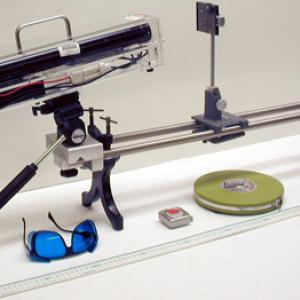College of Liberal Arts & Sciences
6C10.15 - Diffraction - Laser and Adjustable Slit
Put the adjustable slit in the path of the laser beam. As you adjust the slit width observe the changing diffraction patterns.
Another variation of the previous single slit demo is to partially submerge the variable slit in a tank of water. Measurable differences between the pattern produced through the air as opposed to through the water can be observed and used for calculations.
- Christopher L. Panuski and Carl E. Mungan, "Single-Slit Diffraction: Transitioning from Geometric Optics to the Fraunhofer Regime", TPT, Vol. 54, #6, Sept. 2016, p. 356.
- Samuel Hirchman and Eugene Hecht, "What Happens if w< l?", TPT, Vol. 19, #6, Sept. 1981, p. 427.
- Samuel Hirschman, "Diffraction of Light Apparatus", TPT, Vol. 14, #3, Mar. 1976, p. 180, also A Potpourri of Physics Teaching Ideas - Optics and Waves, p. 233.
- Mario Iona, "Comments About Slit Diffraction", TPT, Vol. 10, #6, Sept. 1972, p. 323.
- "O-505. Fixed, Variable & Finger Slit", DICK and RAE Physics Demo Notebook, 1993.
- G. D. Freier and F. J. Anderson, "Ol-7", A Demonstration Handbook for Physics.
- Robert Ehrlich, "Q.10. Variable-Width Slit Using Razor Blades", Turning the World Inside Out and 174 Other Simple Physics Demonstrations, p. 202 - 203.
- Paul Doherty and Don Rathjen, "Diffraction", Exploratorium Science Snackbook, p. 38.1 - 38.2.
- Joseph Frick, "#191 - Experiments on Diffraction", Physical Technics: Or Practical Instructions for Making Experiments in Physics and the Construction of Physical Apparatus with the Most Limmited Means, p. 222.
Disclaimer: These demonstrations are provided only for illustrative use by persons affiliated with The University of Iowa and only under the direction of a trained instructor or physicist. The University of Iowa is not responsible for demonstrations performed by those using their own equipment or who choose to use this reference material for their own purpose. The demonstrations included here are within the public domain and can be found in materials contained in libraries, bookstores, and through electronic sources. Performing all or any portion of any of these demonstrations, with or without revisions not depicted here entails inherent risks. These risks include, without limitation, bodily injury (and possibly death), including risks to health that may be temporary or permanent and that may exacerbate a pre-existing medical condition; and property loss or damage. Anyone performing any part of these demonstrations, even with revisions, knowingly and voluntarily assumes all risks associated with them.
